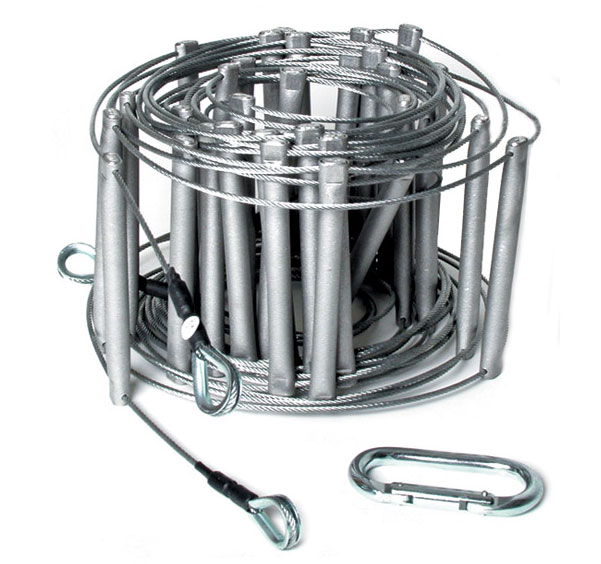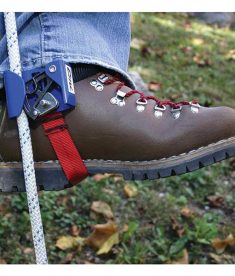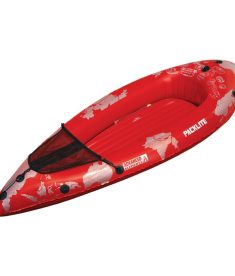Description
Climbing Technique for Caving or Rope Ladders
Climbing a caving or rope ladder is significantly different than climbing a regular ladder. If you try to climb these ladders the same way, you will find yourself with your legs being pushed out to where your body is at an inclined angle from the ground, exerting a lot more strain on both your arms and legs.
- Place first foot on a rung as normal.
- Wrap your other foot around the backside of the ladder and place your heel in the next rung.
- Your hands should follow a similar process, putting one on the front side and one on the backside of the ladder.
- **Important** – Try to consciously push with your legs and not pull with your arms.This climbing process allows the opposite forces, from both sides of the ladder, to keep the ladder more vertical. As a result, this will allow your legs to do the bulk of the climbing, therefore ensuring you won’t burn your arms out on the climb.
This climbing process allows the opposite forces, from both sides of the ladder, to keep the ladder more vertical. As a result, this will allow your legs to do the bulk of the climbing, therefore ensuring you won’t burn your arms out on the climb.
Wire Rope Ladders Safety and Maintenance
- Normally the life of wire rope will depend upon the amount of bending it receives. Bending can be minimized by the following :- (i) If a large anchorage (belay point) causes the ends to diverge excessively an extra trace could be used or a karabiner linked across the “C” clips. (ii) The rungs should be horizontal – not tilted. (iii) If the wires between adjacent rungs tend to form a helix, the ladder has probably passed through itself. This should be corrected so that the wires become relaxed. (iv) Do not walk on the ladder whilst not erected (v) Place padding over sharp edges.
- The site should be cleared of loose rocks and equipment.
- A “C” clip must not have more than one other load bearing “C” clip engaged with it.
- If the previous usage of the ladder is not known, it should be inspected for damage. A few broken wires may not be serious, but any damage should be tagged and reported. (Manufacturer can affect repairs). A good rule of thumb is to visibly inspect the ladder before each use.
- A safety helmet should be worn.
- A safety line is always a good idea, especially on long climbs. There is a variety of belaying devices and techniques available. Those not experienced in this field should seek advice.
- Only one person at a time should be on the ladder.
- A karabiner or snap hook attached at the waist is very useful. The climber can hook himself onto the ladder rung and rest in comparative comfort. It also leaves both hands free.
- CORROSION: Occasional wetting with fresh water will not cause significant corrosion. However, it should be washed if necessary and dried before storage. Greater care will be needed if exposed to sea water. A corrosion retarding fluid could be applied provided it does not make the rungs greasy.
- LIMITATIONS: These ladders are designed for use in situations where the use of a rigid ladder or a safer means of access is not available. They are not intended to withstand the wear and tear of a fixed installation or indifferent usage. However, they are much safer than a single rope and if used correctly should provide many years of faithful service.
Advantages of Using a Steel Caving Ladder Over Alternatives
Steel caving ladders have several advantages over other alternatives:
-
Durability: Steel ladders are extremely durable and can withstand harsh environments, including exposure to the elements, chemicals, and rough handling. They are built to last and can be used for many years without needing replacement.
-
Strength: Steel ladders are stronger than other materials, such as aluminum or plastic, and can support heavier weights. This is especially important in applications where the ladder will be used to support heavy equipment or multiple people.
-
Stability: Steel ladders are more stable than other materials, providing a secure footing for climbers. This is particularly important in applications where the ladder is used in unstable or uneven terrain.
-
Resistance to fire: Steel ladders are fire-resistant, making them ideal for use in applications where there is a risk of fire. This includes industrial settings, as well as emergency escape routes in buildings.
-
Versatility: Steel ladders can be used in a wide range of applications, from caving and mining to theater rigging and marine use. This versatility makes them a valuable tool for a range of professionals and hobbyists.
-
Easy to maintain: Steel ladders are relatively easy to maintain and require little upkeep. They can be cleaned with soap and water and do not require any special treatment or coatings to protect them from the elements. This makes them a low-maintenance option for those who use them regularly.
Applications for Liberty Mountain Steel Caving Ladder
- Events Rigging: The ladder can be used to provide access to high structures such as stages, lighting rigs, or sound systems. It can also be used as an anchor point for rigging equipment.
- Theatre: The ladder can be used to provide access to catwalks, lighting rigs, or other elevated areas in a theatre.
- Confined Space Silo Access: The ladder can be used to provide access to the interior of silos, tanks, or other confined spaces.
- Manhole and Sewer Access: The ladder can be used to provide access to underground structures such as manholes or sewer systems.
- Marine/Pleasure Boats: The ladder can be used as a boarding ladder for boats, or as a means of access to high areas on the boat such as the mast or rigging.
- Military: The ladder can be used for a variety of purposes in military applications, such as providing access to elevated positions, scaling obstacles, or as part of a rappelling system.
- Ropes Courses / Climbing Walls: The ladder can be used as an element in a ropes course or climbing wall, providing a challenging ascent or descent for participants.
- Mining Industry: The ladder can be used for access to high areas in mining operations, or as part of a rescue system for underground workers.
- Fire Escape Ladders: The ladder can be used as an emergency escape route in buildings, providing a means of egress from upper floors.
- Caving: The ladder can be used in cave exploration as a means of ascending or descending vertical shafts or pits.





